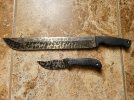- Joined
- Apr 10, 2023
- Messages
- 12
I'm almost done with my first knife, hand forged from 80CRV2. I know you guys get asked a lot of rookie questions, but I can't really find an specific answer to this question anywhere. I hope you don't mind me starting a thread about this.
I finished my first blade, and I like it, but it seemed a bit dull. So, I decided to do a vinegar and mustard patina on a portion of the blade, but every time I try to clean it, most of the patina comes off. It looks great when I first take off the vinegar soaked napkins, but it rinses off when I squirt it down with Windex to neutralize the vinegar. Is it the nature of 80CRV2 just not to get very dark (I was hoping to get it to the same color gray in my handle)? Am I not leaving it on long enough? Should I not wipe it afterwards with ammonia?
Here was my method:
One hour in vinegar, then 30 mins of splotched mustard and repeated for another 30 minutes. Looked great. When I went to clean it up, most of the gray came off. So, today, I left it in the vinegar for 3 hours. Again... it looked great until I sprayed it, then the dark gray turned very light as soon as I sprayed it down.
That's about as dark as it's getting. Any help would be appreciated.
I finished my first blade, and I like it, but it seemed a bit dull. So, I decided to do a vinegar and mustard patina on a portion of the blade, but every time I try to clean it, most of the patina comes off. It looks great when I first take off the vinegar soaked napkins, but it rinses off when I squirt it down with Windex to neutralize the vinegar. Is it the nature of 80CRV2 just not to get very dark (I was hoping to get it to the same color gray in my handle)? Am I not leaving it on long enough? Should I not wipe it afterwards with ammonia?
Here was my method:
One hour in vinegar, then 30 mins of splotched mustard and repeated for another 30 minutes. Looked great. When I went to clean it up, most of the gray came off. So, today, I left it in the vinegar for 3 hours. Again... it looked great until I sprayed it, then the dark gray turned very light as soon as I sprayed it down.
That's about as dark as it's getting. Any help would be appreciated.




















